Ever since “Jaws” came out we’ve all had great respect for the shark, though most of us got familiar with this creature solely from the TV screen.

Years later, as fish keepers, we find ourselves wondering about the cool possibility of owning some of the freshwater-loving aquarium-suitable sharks at home.
Such species do exist but, inevitably, questions about size and diet arise. Not everyone can afford to have a huge fish tank in their home.
So, are there any pet shark types that remain small, and won’t outgrow a typical home aquarium? And if there are, which is the smallest one??
On the other hand, are there any big freshwater sharks that are also suitable for domestic keeping? And what food would such a vicious predator even need??
It’s time to Aquanswer these questions.
Sharks are marine in nature, though some types are known to roam both fresh and saltwater. However, these are true sharks. You know, the ones famous for their appetite for flesh and their aggressive behavior.
None of the fish listed below are actual “sharks”. They are all shark look-alikes, mostly coming from the Shark Catfish family also known as Pangasiidae, and some from the minnows and carps group, collectively known as Cyprinidae.
However, they will share the behavior and appearance of true sharks.
Some will be aggressive, lonely bottom roamers and will prey on smaller fish if given the opportunity.
Do you want to watch this article instead of reading it? Checkout the highlight video below from our YouTube Channel (Or read the more detailed article below), be sure to Subscribe For More Great Fishkeeping Content:
Generally speaking, keeping most of these shark wannabes won’t be a challenge for a knowledgeable freshwater fishkeeper.
Some will demand a little more resources in terms of living space and food, but there’s a good chance that you’ll find one or more that are suitable for your fish tank setup.
It should be noted that most of these fish will grow over 5 inches in length upon maturity.
It’s in their nature. If you’re on the look for species suitable for stocking your nano aquarium (anything under 10 gallons) I recommend that you check my list of micro pet fish for freshwater tanks.
I made sure to give out the initial information about their care alongside some actionable advice for each type.
If you find this article helpful, you should probably bookmark it and come back later when you’re ready to make your final decision on your new shark pet.
Which are the freshwater shark kinds suited for home aquariums?
Freshwater aquarium sharks are deliberately employed by some fish-keeping enthusiasts in an attempt to achieve a shark-tank look. Listed below are types of fish that can be used to achieve this, but mind their companions when choosing.
Have a look at the freshwater sharks that can be kept in fish tanks at home:
1. Rainbow Shark – Epalzeorhynchos frenatum
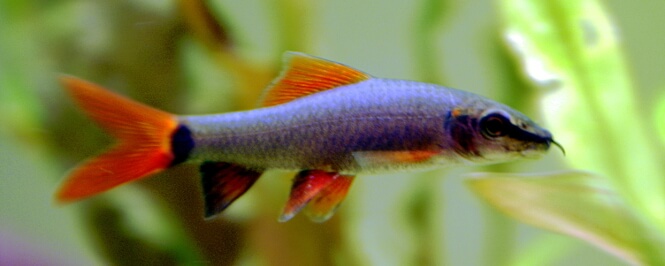
| Max. size: | 6 inches (15.24 cm) |
| Suggested tank size: | 55 gallons for a single adult specimen |
| Tank mates: | Rainbowfish, danios, barbs, gouramis, rasboras, semi-aggressive cichlids, NO goldfish and bottom-dwellers |
| Ph: | 6.8 to 8 |
| Water temperature: | 75 to 85°F (23.9 to 29.4°C) |
The rainbow shark is a relatively tiny species of fish, reaching up to 6 inches or 15 cm in length.
The tricky part to housing one of these is not the aquarium size, but rather the other inhabitants.
The Epalzeorhynchos frenatum members fall on the aggressive side of the hobby. They will inevitably become territorial with age and will try to occupy certain parts of the fish tank as their own.
They are bottom-dwellers in their nature, so housing them with plecos, loaches, and other bottom-feeders is not a good idea.
A smart move would be to introduce them in a community tank with fish that inhabit the top of the aquarium such as danios, barbs, and so on.
If you want to keep more than one, I suggest that you provide them with a large tank of at least 100 gallons, which has lots of caves and plants.
This way the rainbow sharks can hide and “claim” their living space, without tearing each other apart.
The suggested tank mates remain unchanged as it is the same animal, with the same behavior, that’s simply genetically modified to glow in the dark and nothing more.
With proper care a rainbow shark will live for about 6 to 10 years, depending on water conditions and stress levels in the tank.
Breeding is possible although, not recommended for beginner hobbyists.
You’ll need a 75-gallon breeder without a filter.
You’ll need to manually clean the tank and perform daily 25% water changes.
There’s a high chance the male and female rainbow sharks won’t tolerate each other.
Male rainbows have brighter coloration than the female and a body that’s somehow thin, compared to the female’s round-ish torso.
By the way, it’s a common misconception that the rainbow shark is a nocturnal animal. In reality, they aren’t just as active during the day.
Sometimes if the fish is stressed it will prefer to swim when the lights go off, and mostly hide for the rest of the time.
I recommend the following equipment for a single Rainbow Shark:
- Lighting: I strongly recommend trying out the Finnex Planted + 24/7. This aquarium light will grow virtually any plant you have, which can be important for providing more shelter to your Rainbow Shark.
- For maintaining good aquarium filtration for your Rainbow Shark, you can try one of these Canister filters: Fluval 407 Performance Canister Filter. The Fluval 407 is suitable for 55-gallon fish tanks that have less than 80% bioload. For a fully stocked 55-gallon aquarium, I recommend checking out the Penn Plax Cascade 1500 Canister Filter on Amazon (which you can also order over at Chewy).
- For a stable water temperature: See if you can get the Eheim Jager heater (check it out on Amazon here or see if there’s a deal at Chewy). The 300-Watt Jager will maintain the tropical water temperatures a Rainbow Shark needs to thrive.
2. Roseline Torpedo Shark – Sahyadria denisonii
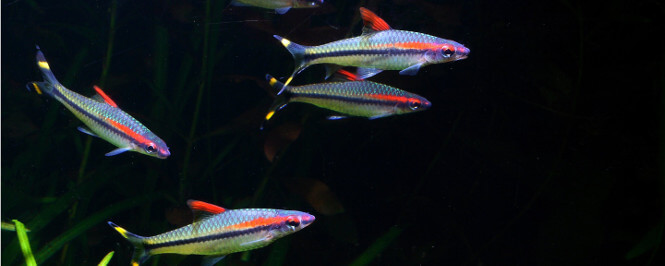
| Max. size: | 5 to 6 inches (12.7 to 15.2 cm) |
| Suggested tank size: | 75 gallons or more, preferably 125 gallons |
| Tank mates: | zebra danios (school), tiger barbs (school), black skirt tetras (school), siamese algae eaters, fast-swimming cichlids such as the Bolivian ram |
| Ph: | 6.6 to 7.6 |
| Water temperature: | 72 to 77°F (22.2 to 25°C) |
The Roseline shark, also known as Denison Barb or Red-lined Torpedo barb is a great addition to a home shark-centered tank. They are a really beautiful species that schools together nicely and also does not grow super large in size.
In fact, I’ve included this species in my list of the prettiest and most cool-looking freshwater fish in the aquarium hobby. Roseline Sharks are also one of these unique freshwater fish with vivid color patterns on their bodies (click the link to see more such fish).
Anyway:
The Roseline shark reaches up to 6 inches (15.2 centimeters) upon maturity, classifying it as one of the smallest shark pets suitable for freshwater home aquaria.
Their growth rate is not that fast either – expect yours to gain about 1.5 inches per couple of months with good feeding.
The best approach would be to add a few at once, because otherwise, you may witness chasing and bullying.
Given their size and the typical speeding back and forth, it’s advisable to provide them with a long aquarium.
An ideal setup for a shoal of torpedo barbs would be a 125-gallon fish tank that is 6 feet long and has plenty of other fast-swimming community fish.
The faster movements will stress out the slow swimmers, so it’s not a good idea to house Roseline sharks with angelfish or discus.
Good tank mates for a school of red-lined barb sharks will include zebra danios, black skirt tetras, tiger barbs, siamese algae eaters, Bolivian ram cichlids, etc.
Feed your red-lined barbs live food such as daphnia, bloodworm, shrimp, and cyclops.
They are omnivores so they’ll also appreciate vegetables, which will help them with digestion.
Here’s the aquarium equipment needed for a school of 6 Roseline Torpedo Sharks:
- Lights: The LED lights I recommend, for a 75-gallon aquarium with 6 Roseline Sharks, are great in providing enough brightness for bigger tanks and can grow a lot of aquarium plants. The lighting fixture is called Current USA Satellite Plus PRO and you can check it out on Amazon or compare their pricing at Chewy.
- Heater: For heating the tank, I recommend using Eheim Jager aquarium heater, because it is strong enough to keep a stable water temperatyre and has glass jackets which ensure even heat distribution.
- Filtration: To filter the water in a 75-gallon tank with Roseline Sharks I’d recommend a good canister filter such as the Aqueon QuietFlow 400 (at Amazon.com). Whatever filter you use, make sure it’s a canister one and also that it has at least 400 GPH of estimated water turnover.
3. Bala Shark – Balantiocheilos melanopterus
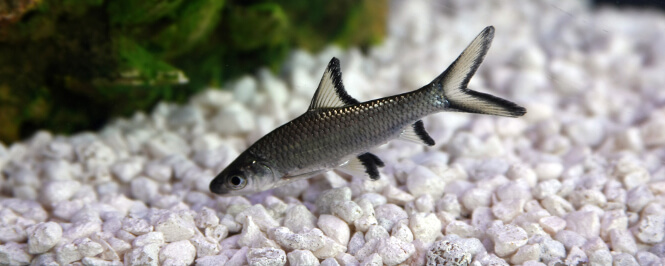
| Max. size: | 15 inches (38.1 cm) |
| Suggested tank size: | 75 gallons for a single specimen and 200 (but preferably 400) gallon tank for a school of 3 or more |
| Tank mates: | semi-large peaceful fish, that do not fit in the Bala’s mouth. clown loaches, gouramis, angelfish, tiger barbs, cichlids, even Oscars |
| Ph: | 6.5 to 7.8 |
| Water temperature: | 72 to 83°F (22.2 to 28.3°C) |
The Bala shark is a welcome option for medium-sized tanks, as this fish reaches around 15 inches (38 centimeters) upon maturity.
This means that one Bala would feel comfortable in a 75-gallon tank.
However, this fish is somewhat social and, unlike most other aquarium shark species, prefers the company of its own kind.
A school of 3 is recommended if you want it to feel welcome and happy in your fish tank.
This implies a much larger tank though: 200 gallons of water with plants and decor would be best as a setup.
The Balantiocheilos melanopterus is a relatively fast grower at first, but after passing the 5-inch mark, it will gradually slow down its growth.
They do live long – a lifespan of 10 or more years is to be expected with proper care in a stress-free environment.
The tank companions of the Bala shark should not be aggressive and small enough to get eaten.
Avoid housing them with smaller tetras, danios, guppies, platies, mollies, and smaller cories.
Bala Sharks will also eat most snails they come across. This leaves lots of options, and I’ve seen people housing them will almost any semi-large fish.
Here’s a video of a fellow fishkeeper showing off with his beautiful aquarium of a school of 3 Balas and a couple of other suitable tank mates. A tricolor shark (the other name of a Bala) will eat almost everything it’s given.
Not a picky eater by any means they will munch on small crustaceans such as shrimp, bloodworm, earthworm, small insects, mosquito larvae, and even some forms of algae.
Being omnivorous the silver shark will also accept blanched vegetables and high-quality flake foods in its diet.
The Bala shark is also really hardy when it comes to water parameters.
This makes the larger tank size the only barrier that newer fishkeepers are facing if pursuing a Bala-centered tank.
Anyway, I recommend the following aquarium gear for a single Bala Shark:
- Lighting: Bala Sharks are not pretentious about having a planted tank so a basic budget light such as the NICREW Classic LED would do.
- For filtration of a 75-gallon tank with a single Bala Shark, I recommend using the Aqueon QuietFlow 400 Canister Filter. It provides a flow rate that will keep a large tank with messy eaters clean.
- Heater: For the heater I personally would choose 300-Watt Eheim Jager, because it’s pretty much precise when it comes to keeping a particular water temperature in larger aquariums. You can also see it on Chewy, where it is often on a deal.
4. Pink-Tailed Chalceus – Chalceus spp.
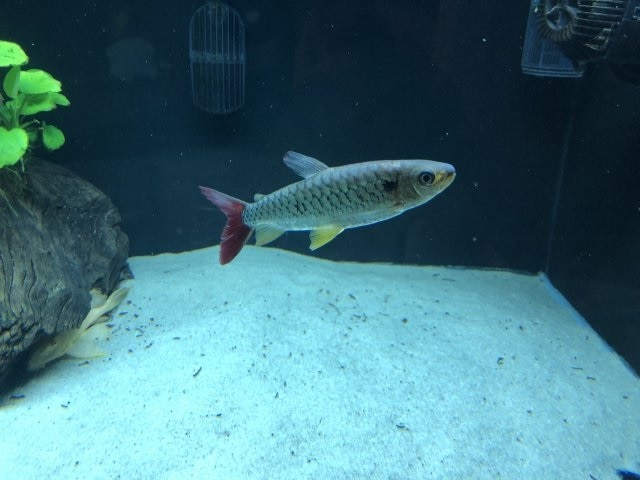
| Max. size: | 12 inches (30.48 cm) |
| Suggested tank size: | At least 200 gallons for a school (length and width are more important than depth) |
| Tank mates: | Semi-aggressive fish with similar size, no top-dwellers |
| Ph: | 6 to 7.5 |
| Water temperature: | 73 to 85°F (22.8 to 27.8°C) |
The Pink-Tailed Chalceus Shark is a somewhat rare freshwater fish in the aquarium trade.
I’d usually see this fish kept as a pet by seasoned “monster fish keepers”.
There are more than one species of Chalceus sold under different names, and though they look slightly different, their behavior always resembles that of a true shark.
You could also see this fish labeled as Red-Tailed Chalceus.
Anyway, the Chalceus Shark is a semi-aggressive fish that dwells near the water surface and grows to no more than 12 inches (30.5 cm).
However, 12 inches is the best case scenario, and typically the Chalceus Shark reaches around 9 to 10 inches or between 22.8 and 25.4 cm.
Aside from growing relatively large, this fish also needs plenty of swimming space as each one I’ve seen has been a very active swimmer.
Pink-tailed Chalceus sharks appreciate a lengthy aquarium and I would not put one, even a juvenile, in a tank that has less than 48 inches of length.
These fish are also very good jumpers and will try to fly off if they can…

Anyhow, tank width also plays a role if you want to keep these fish, because of their schooling nature.
Typically, it would be best if you keep a school of no less than 6 Pink-tailed Chalceus.
Author’s note: In my observations, another option would be to keep just a single specimen. That’s simply because these fish tend to fight among themselves in smaller groups. So either go with one or with a group of at least six.
Anyway, the Chalceus Shark is an omnivore but the majority of its diet should be meaty foods.
It will eat pretty much any insect, small fish, or crustacean.
And finally, since the Pink-tailed Chalceus Shark can be somewhat anxious at times, I’d recommend adding some floating plants to its tank.
The floaters will reduce the chance of the fish becoming nervous for whatever reason. I have a post that lists a good selection of floating aquarium plants that you could check.
5. Harlequin Shark – Labeo cyclorhynchus

| Max. size: | 6.5 inches (16.5 cm) |
| Suggested tank size: | 55 gallons |
| Tank mates: | semi-large fast-swimming fish with a similar temper |
| Ph: | 6.5 to 7.5 |
| Water temperature: | 72 to 83°F (22.2 to 28.3°C) |
The harlequin shark is an uncommon home aquarium shark species that has an unusual appearance.
Youngsters have a brighter coloration that will fade upon entering maturity, but not entirely.
Still a stunning look, in my opinion.
The maximum size of the harlequin sharks in captivity would be around 6 inches or 15.2 centimeters.
They are a suitable addition to your 55-gallon tank when it comes to size.
These guys are your typical shark-like fish though.
Like many on this list, a harlequin shark won’t tolerate its own.
In fact, it hates being around anything that even resembles its own.
So much that there was never a record of successful breeding in-house.
They lean heavily on the solitary side of life.
Other catfish (or bottom-dwellers, for that matter) will inevitably get bullied and if given the opportunity, killed.
If you plan to get this shark for your freshwater tank, don’t ever add anything that even gets close to the bottom.
They like their safe space as well.
Your tank must be well-planted, with plants that are durable and robust.
The decor should include driftwood and rockwork that provide enough hiding places for the shark to explore.
The harlequin shark is an aufwuchs grazer, which means it will snack on biofilm, detritus, and algae.
Keep your harlequin shark with similar-sized fast swimmers that inhabit the mid and topwater column.
Minnows and carps will do well, as will larger barbs and danio species.
Fun fact: This shark prefers a noticeable current as its natural habitats are rivers. Having a strong canister filter or a good powerhead that provide stream-like environment is highly appreciated.
6. Red-tailed Black Shark – Epalzeorhynchos bicolor

| Max. size: | 5 to 6 inches (12.7 to 15.2 cm) |
| Suggested tank size: | 55 gallons or more |
| Tank mates: | zebra danios, tetras, tiger barbs, clown loaches, angelfish, gouramis |
| Ph: | 6.5 to 7.6 |
| Water temperature: | 74 to 80°F (23.3 to 26.6°C) |
The Red Tail Shark (Epalzeorhynchos Bicolor) is an outstanding example of a freshwater shark fish.
This type of shark has a dark blue to a black-colored body that complements its red tail. Red Tail Sharks can reach up to 6 inches in size (15.2 cm), though most of them tend to grow up to around 5 inches (12.7 cm).
With its rather tiny size, this mini fish pet is suitable for smaller home aquaria.
Unlike with most other sharks listed here, you can get away with a 55-gallon tank for that shark species.
Their lifespan is around 7 years with good care.
The aquarium décor is important for the well-being of the red-tailed sharks – they need plenty of wood, different-sizes rocks, opulent planting, and a touch of fine gravel.
It’s advisable to place some tree roots and branches, as they need their hiding places.
Use bright aquarium lighting for aquatic plants – it will cause the accumulation of algae, which is important for the Red Tail Shark’s diet. However, don’t consider this shark a fish tank cleaner, as the amount of algae it consumes is not by any means impressive.
To supplement a healthy menu you should feed maggots, small crustaceans like brine shrimp, and also some veggies such as spinach, cucumbers, and the occasional slice of fruit.
When juvenile this fish is timid and it will mainly look for places to hide.
When it matures, however, the red-tailed black shark will become pretty territorial.
This is why some hobbyists tend to avoid this species.
Still, being informed is an advantage as there are some compatible tank mates to choose from.
It’s simple – just avoid other species that have similar appearance and shape or red coloration – as they will be considered targets.
The Red-Line Torpedo and other freshwater shark species like the Rainbow shark are to be avoided as tank companions.
Housing your Red-tail with other species that roam the bottom is not a good idea as well.
You can pick tank mates, who spend most of their time in the upper level of the tank.
Some strong and healthy barbs and tetras, for example, are a good option, but make sure they form a school to avoid further aggression.
Robust loaches can be suitable as well but do the proper research beforehand.
This way it won’t be able to mark most of the aquarium as its own and the number of territory disputes can be greatly decreased.
The Red Tail shark prefers the solitary lifestyle and it tends to look for a friend only when sexing. If you decide to keep more than one, bear in mind that you’d need at least 3.5 feet (1 meter) of horizontal aquarium length.
7. Siamese Algae Eater – Crossocheilus siamensis
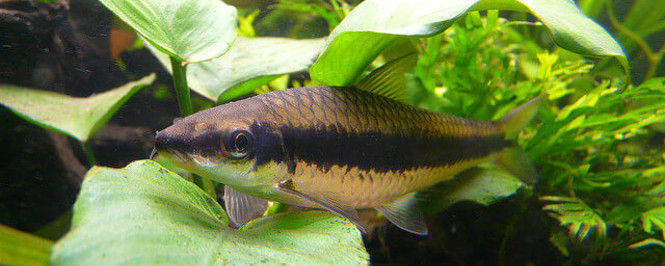
| Max. size: | 6 inches (15.2 cm) |
| Suggested tank size: | 20 gallons long |
| Tank mates: | barbs, tetras, and danios (if in a school of 4 or more), gouramis, angelfish, corydoras, guppies, swordtails |
| Ph: | 6.5 to 8 |
| Water temperature: | 76 to 80°F (24.4 to 26.6°C) |
I have a comprehensive guide on the Siamese algae eater (SAE for short) which is notorious in the aquarium trade for its ability to destroy algae infestations top to bottom.
In fact, I’ve also listed it at #1 in my list on the 17 19 finest aquarium algae eaters. It resembles a small shark in appearance, same as with the flying fox fish and the Chinese Algae Eater.
It should be noted that these are all different species of shark look-alikes because there’s too much disinformation online claiming otherwise. Anyway, the SAEs grow up to 6 inches in length (a little over 15 centimeters).
Unlike other aggressive fish on this list, the Siamese Algae Eater is quite peaceful in nature and likes to hang out with other peaceful community fish. The only fish it won’t really tolerate would be other similar-shaped shark-like freshwater species such as the rainbow and red-tailed shark.
Because of its calm temper, you can get away with a smaller tank for its habitat.
A 20-gallon long tank could provide enough space, but, of course, in this hobby, bigger is better. My experience has been that you can house multiple Siamese algae eaters in the same fish tank, without any territorial issues among them.
There’s a very basic rule of mine that I follow:
Introduce roughly one SAE per 15 gallons of water, but this does not equally apply to mature full-grown ones, as they’ll need more than that because they are bottom-dwellers after all.
Appropriate tank mates for a Siamese algae grazer are virtually all non-aggressive community fish.
These guys are also known to jump, so make sure your aquarium has a lid on.
8. True Flying Fox Fish – Epalzeorhynchos kalopterus
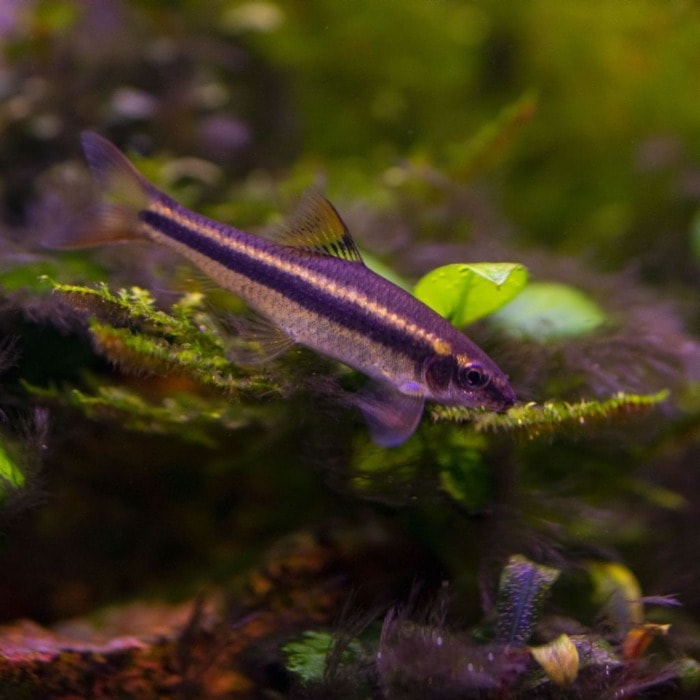
| Max. size: | 6 inches (15.24 cm) |
| Suggested tank size: | 100 gallons |
| Tank mates: | Schooling dither fish such as danios, rasboras, and barbs. |
| Ph: | 6.0 – 7.5 |
| Water temperature: | 68 to 79°F (20 to 26.1°C) |
The True Flying Fox fish from the Epalzeorhynchos genus is a small freshwater “shark” that often gets mistaken for a SAE.
SImilarly to the SAE, it has an elongated, slender body that’s marked by a horizontal black stripe.
However, it has an additional iridescent brown line that’s not present in siamese algae eaters.
Furthermore, some flying fox fish can have dark or reddish fins, whereas those of siamese algae eaters are typically translucent.
Apart from the striking visual resemblance, both species also share an appetite for algae.
Unfortunately, flying fox fish aren’t nearly as good at taking care of aquarium algae infestations as their Chinese look-alikes. Being sly like their terrestrial namesakes, these fish quickly learn to wait for food so they abandon their passion for algae once they adapt to the aquarium.
So if you’re searching for a cleaner shark, it would be better to go with the SAE instead.
Anyways, flying fox fish aren’t picky eaters and will readily eat flakes, granules, and sinking pellets.
If you want to see them thrive, you should feed them with frozen meals like tubifex worms, daphnia, or bloodworms twice a week.
Bear in mind that bloodworms should be given only as a treat since they’re hard to digest and can cause a food blockage. In the wild, flying fox fish inhabit fast flowing rivers and streams that are rich in oxygen.
Due to this, they are quite sensitive to waste buildup and require pristine water conditions.
To keep them healthy, you’ll need to regularly monitor nitrate levels and change at least 15% of their water every week.
Using a powerhead or airstone is also a good idea since it will increase the freely available oxygen in the aquarium water.
In terms of behavior, flying fox fish tend to be highly territorial so they shouldn’t be housed with other bottom dwellers or their own kind.
They also don’t bode well with other similarly looking fish like the Red-Tailed Shark or Rainbow Shark, so you should avoid those as well. Otherwise, they pretty much don’t bother schooling dither fish, which makes them a great tank mate for danios, barbs and tetras.
9. Black Sharkminnow – Labeo chrysophekadion

| Max. size: | 35 inches (88.9 cm) |
| Suggested tank size: | 200+ gallons for adults |
| Tank mates: | fast-swimming fish that do not look like sharks and inhabit the upper space of the water column |
| Ph: | 6.6 to 7.5 |
| Water temperature: | 75 to 82°F (23.9 to 27.7°C) |
The black shark minnow is not for everyone and is to be avoided if you’re new to the hobby.
Why?
Because these fish grow super large and are highly aggressive, that’s why.
A black Labeo (as they are also known) will reach around 30 inches in captivity (75 centimeters).
It will become very aggressive towards other smaller fish, once they grow large enough.
The black shark will occupy the bottom of the tank, so housing it with other bottom-dwellers or similar-looking fish is not recommended.
They may get along with tank mates that mainly swim in the upper space of the aquarium.
If you’re about to introduce this freshwater shark to your, *ahem*, 200-gallon fish tank, make sure it is the last newcomer there.
Otherwise, they won’t allow other newly-introduced fish to feel comfortable and will chase them around, stressing everyone.
They have an albino version that’s specially bred for the aquarium trade.
Looking after a black Labeo is definitely for monster-lovers and often the best practice is to have a single shark in a tank with no other tank mates.
If you can provide it with a larger tank of about 400 gallons, then housing it with fish similar in size would be possible, but only if these are dwelling the mid and top of the tank, as I already mentioned.
Given the size of this fish, a top-notch aquarium filter is a must.
Another thing to keep in mind when caring for these robust monster sharks is well-oxygenated water.
They will appreciate large water changes.
Use fine sand as a substrate and avoid sharp decorations, as the black Sharkminnow is prone to damage from these.
Feed 2 times a day, as these fish are grazers by nature.
10. Iridescent Shark Catfish – Pangasianodon hypophthalmus

| Max. size: | 47 inches (120 cm) |
| Suggested tank size: | 400 gallons for a single specimen |
| Tank mates: | larger minnows and carps, Oscars, pacu fish, common pleco, NO fish that will fit in the ID shark’s mouth |
| Ph: | 6.2 to 7.5 |
| Water temperature: | 72 to 79°F (22.2 to 26.1°C) |
The reason I’m including the Iridescent shark in this list is that I see it being sold in almost every fish pet store.
However, my intentions are to warn people that want one of these for their aquarium.
Read on carefully and you’ll see what I’m talking about.
The Pangasianodon hypophthalmus has a natural lifespan of 15 years, with some individuals making it to 20.
The long life comes with being a rather slow grower.
An Iridescent shark will grow with roughly 1-1.5 inches per 3 months.
If being fed more often and given spacious living space, they won’t feel confined and may grow a bit faster than that.
The thing is…
these creatures grow large.
Many of the other sharks on this list that end up super huge are not so easy to find in local fish stores and are only delivered by special places that sell aquarium fish online. However, the ID shark, despite being endangered can be found in most local fish stores and people do buy them, not knowing what to expect.
Pangasianodon hypophthalmus members can reach up to 3.3 feet (1 meter) in length.
They are also quite the active swimmer and don’t like to rest around like other big aquarium fish.
In the wild, they migrate to faraway places and are used to constant swimming.
This implies you’ll need no less than a 400-gallon tank for a single mature specimen.
The more responsible fishkeepers keep them in 1500 gallon tanks, where the Iridescent sharks feel a little less confined.
Not cool.
Another thing to be aware of is that if you keep your ID shark in a smaller tank, it won’t grow much (around 12 inches) but it will die prematurely.
Getting one of these is not a good idea unless you’re prepared.
Only get one if you’re one of those fishkeepers that would provide it with a comfy home.
A suitable home with good tank mates for the iridescent shark would be one with larger non-aggressive fish in it.
Territorial bottom-dwellers such as plecos are fine because the ID shark occupies the middle and top of the water column.
Larger cyprinids, Oscars, and pacus would also make good tank companions for it. Anything smaller will get eaten.
11. Silver Apollo Shark – Luciosoma Setigerum

| Max. size: | 9 inches (22.9 cm) |
| Suggested tank size: | 75 gallons long and above for a single specimen, and 150 or more for a school |
| Tank mates: | other similar-sized cyprinids, barbs and loaches, Bala sharks, calm plecos |
| Ph: | 6 to 6.5 |
| Water temperature: | 70 to 78°F (21.1 to 25.5°C) |
Two species are known under the name Silver Apollo Shark – Luciosoma Pellegrini and Luciosoma Setigerum.
Both have similar needs in terms of care and share almost identical behavior.
Their max size in captivity is 9″ (or 22.9 cm).
The Silver Apollo Shark is an actively schooling fish, who feels best in a group of at least 6 members.
They mainly occupy the middle and the top of the aquarium and they like to roam the tank a lot.
A single specimen needs at least a 75-gallon long aquarium for its swimming space.
You can decorate your fish tank with floating plants to make them feel at home.
Silver Apollos also like to swim around wood structures such as driftwood.
They do require noticeable water movement and, of course, high-end filtration to thrive.
The recommended temperature is between 70 and 78 degrees Fahrenheit (~21 to 26 degrees Celcius).
They enjoy an acidity of 6 to 6.5 and moderately soft water conditions – 5 to 7 dH.
The Silver Apollo Shark is quite an impressive jumper when challenged, so make sure that you place a hood or some sort of cover-up over your tank.
This freshwater shark is an omnivore and it likes most floating foods – flakes, pieces of veggies, krill, small river shrimps, small pieces of prawns.
Insects and worms as an occasional treat will be greatly appreciated.
These Silver shark pets are rather peaceful, just make sure that their tank mates are big enough and don’t fit in their mouth.
Most species that mainly live and feed on the water’s bottom are a good idea as companions.
Just avoid keeping them together with Rainbow and Red-tailed sharks, unless your tank is above 100 gallons.
Schools of barbs, tetras, and non-aggressive loaches are all good tank mates for your Silver Apollo.
The first grows up to 12″ and is much more aggressive.
It’s not a schooling fish, even though it’s being sold as a Silver Apollo who is, in fact, schooling.
It’s not uncommon that the misinformed fishkeeper buys both species unknowingly in an attempt to keep a school.
Ultimately the Longfinned Apollo kills the other Apollos…
When juvenile the long-finned Apollo still looks larger than the others, so you might be able to tell it’s not what you’re looking for by the size.
It’s a difficult task to tell them apart, so keep a sharp eye out!
12. Violet Blushing Shark – Labeo boga
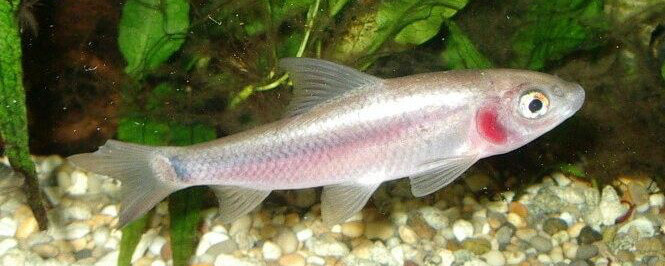
| Max. size: | 12 inches (30.5 cm) |
| Suggested tank size: | preferably 125 gallons |
| Tank mates: | Clown loaches, larger peaceful Cyprinidae, rainbowfish, Devarios |
| Ph: | 6.6 to 7.9 |
| Water temperature: | 68 to 77°F (20 to 25°C) |
The violet blushing shark is another freshwater fish that’s worth mentioning.
It’s part of the Labeo genus, which consists of sharks quite similar to the representatives of the Epalzeorhynchos genus (such as the Red Tail Shark and the Rainbow shark).
However, these guys are larger and have a bit more elongated body shape.
The VBS can reach up to 12″ in size (or around 30 cm).
This shark pet is not the most outstanding one as there are others that would immediately catch your eye with their vibrant colors.
The thing is that if you consider getting this blushing friend, you’ll need a big tank – at least 125 gallons.
These guys enjoy a current and some rocks, branches, and soft gravel so that the surrounding environment reassembles the bed of a flowing river.
The Violet Blushing Shark is a bottom feeder – it will happily feed on dried fish food and frozen bloodworm.
The only rule is not to house it with other species with a similar shape, especially other members of their Labeo genus, as they will become territorial and aggressive among each other.
It’s recommended to choose between keeping a single specimen or a school of 5+ members. Anything in-between may result in territory disputes.
13. Columbian Shark – Ariopsis seemanni
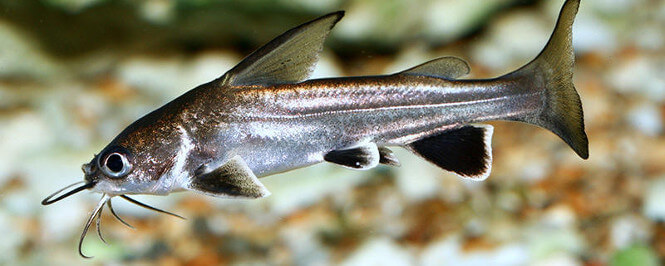
| Max. size: | 20 inches (51 cm), but there are records of them growing bigger |
| Suggested tank size: | preferably 125 gallons |
| Tank mates: | Moonfish, Mollies, Scats and other semi-aggressive marine fish |
| Ph: | 6.6 to 7.5 |
| Water temperature: | 74 to 80 °F (23.3 to 26.6°C) |
I often see the Columbian shark listed as a freshwater tank fish. This is, however, misleading at the least because this is actually a species of catfish that prefers living in brackish water.
That’s why I decided to feature this compelling candidate on this list.
I’d really like to finally bust that myth going not only around the internet but even in some of the pet stores that I’ve visited.
I can clearly see why the Black Fin shark (another name for a Columbian shark) is used as a clickbait – it has a really impressive appearance – at least in my opinion.
Of course, there is some truth to the information that the click baiters use:
In terms of size the Columbian Shark can reach up to 20 inches (51 cm) and if treated well they can grow even bigger.
Bear in mind that you’ll need at least a 75-gallon long tank, as they also love swimming far and fast.
They do enjoy current based on my observations so if you want to make them happy do a setup properly.
The Columbian sharks prefer to be in groups of 4 or more.
They are omnivores and they tend to eat smaller tank mates when they outgrow them.
They can swallow up to 65% of their body length.
This implies that they should not be housed with fish that are less than twice of their size.
It’s a common practice to keep them alongside smaller species, for example, some less aggressive Cichlids at first.
When the Shark cats are still small it will be fine.
However, monitor their growth and make sure you move them to a bigger MARINE tank. Also, be sure there are suitable tank mates that do not include any small saltwater fish species.
Compatible companions would be semi-aggressive marine fish such as the Moonfish.
Other fish with similar water condition needs and still big enough to not be considered as prey – like large mollies or scats are a good tank mate option for the Columbian shark.
Anyway, the Columbian sharks should be fed with various foods – meat, and plants that have the vitamins and minerals needed to maintain a strong immune system.
That includes but is not limited to catfish pellets, shrimp pellets, frozen worms, high-quality flakes, occasional feeder fish, small life crustaceans, cucumbers, etc.
They are scavenging bottom feeders in nature, but may also roam the water column for food.
14. Chinese High-Fin Banded Shark – Myxocyprinus asiaticus

| Max. size: | 50 inches (127 cm) |
| Suggested tank size: | 300 gallons, larger ponds |
| Tank mates: | loaches, koi fish, goldfish |
| Ph: | 6.8 to 7.6 |
| Water temperature: | 55 to 75°F (12.7 to 23.8°C) |
Stunning appearance at first glance!
Though it looks like one the High-fin banded shark is not an actual shark but rather a catfish.
What you should know about these fish?
Well, stay away from them. Unless you’re a monster fishkeeper with a 300-gallon tank in your basement I’d recommend avoiding one of these.
This fish grows immensely large for a home aquarium and will quickly outgrow whatever you were thinking to house it in if that’s under 300 gallons of living water space.
The Chinese high-fin starts out small at about 2 or 3 inches.
However, by the end of year 1, your high-fin banded shark would be nearing 9 inches in length.
Fast forward 3 years and you’ll have a monster that’s over a foot long (50 centimeters or more).
This fish grows at a fast pace.
Its final maximum size will depend on the environment, but a common measurement states over 4 feet.
Your tank will quickly turn into a single-species aquarium, unless you provide it with a really large tank or, perhaps, a pond.
In some fish stores, they may get recommended as an algae eater.
Not really a bad recommendation, as they are aufwuchs grazers and will snack on a lot of algae.
Author’s note: The Chinese high-fin tolerates colder water temperatures, and so is a great algae eater for Koi ponds. If your Koi pond is overgrown with algae and you’re looking for algae eaters that can tolerate a cold climate, I recommend getting this shark.
Anyhow, the Chinese High-fin Banded shark is a really calm fish and it doesn’t swim much.
It’s not aggressive by any means and it can be housed with smaller fish such as clown loaches.
As juveniles, Chinese high-fin sharks can be kept in “shark tank” types of habitat as long as the temperature is lower and the water is not acidic (below 6 pH).
Later, when they get bigger a relocation to a koi pond would be a good idea, because of the behavioral similarities they and the koi fish share.
Keep in mind, however, that it’s an algae grazer so it will need vegetable matter in its diet.
Supplying your high-fin banded shark with bottom-dwelling invertebrates and crustaceans is also a good way to diversify its menu.
This is an endangered species.
Will a larger species outgrow the size of its aquarium when mature?

Since I’ve been getting quite a lot of questions about this, I think it’s time to clear this one out.
Here’s if a baby shark of a large species will outgrow its aquarium when mature:
Larger species of freshwater sharks as any other fish will experience stunted growth in an aquarium environment. This is mainly due to the build-up of nitrates, and the lower levels of oxygenation in a home fish tank. In the wild, a vast body of water will instantly dissolve most impurities. In a home fish tank where space is confined and the only way of removing toxins from the water is human intervention, this is not possible.
That being said, here are the major factors that contribute to stunted growth in a fish tank:
- Build-up of nitrates. Though freshwater creatures are more sensitive to nitrates than marine life both will be affected. Some studies suggest that exposing freshwater fish to higher levels of nitrate can hinder the development of body mass. In our freshwater aquariums, the only way to remove nitrate is through water changes. Plants do consume it, but they are not enough to completely prevent its presence.
- Lower oxygen levels. Again, it has been long proven that lower oxygen levels do stunt the growth of fish. Bodies of water in the wild have an enormous surface area and are therefore very well naturally oxygenated. In our home aquariums, we can increase water movement to agitate the surface and increase oxygenation, and that seems sufficient for survival. However, this can’t be compared to a large lake, a fast-moving river, or an ocean.
The temperature of the aquarium’s water also plays a role in the growth of our pet fish.
Colder water naturally has more oxygen in it.
We can’t go below our beloved fish’s temperature requirements or we risk causing them great discomfort and shortening their lifespan.
However, as established above, our aquariums are not as oxygenated as the fish’s natural environment.
This, in turn, leads to stunted growth.
Obviously, a shark that’s about to grow up to 8 feet will not do well in a 55-gallon tank and it will need relocation sooner or later.
However, a larger species will experience stunted growth to a degree in a home aquarium.
This is why it’s recommended to get species of freshwater sharks that remain rather small in their maturities such as the Dension barb (Roseline torpedo shark) or a red-tailed shark.
Taking proper care of your shark pet
As you can see the first step towards picking a vicious-looking predator as a home pet is choosing the right aquarium setting and the right tank mates. Aside from that, there are a couple of things you need to remember if you are to become the owner of a shark fish:
- Get the long tank – aside from growing, fish that exhibit shark-like behavior are natural explorers. Mostly being bottom-dwellers what concerns them is the total area of your aquarium’s bed. A longer tank will provide your pet with lots of roaming space, making it feel like a real sneaky predator.
- Provide a decent filtration – larger fish produce more waste. Larger carnivorous fish produce EVEN more waste. Having a decent aquarium filtration system is a must when keeping such creatures. Controlling Ammonia spikes is not a pleasant process and they are pretty lethal to fish tank inhabitants. Canister filters are the best at providing a safe level of filtration for larger fish tanks containing messier fish.
- Keep a tight lid on at all times – few exceptions aside, the freshwater sharks are jumpers. Keeping an eye for a possible fish suicide spoils the fun of having an aquarium in the first place. Make sure there’s a lid over yours.
- Set a soft substrate – bottom-dwellers still have sensitive bellies which predispose them to injury from sharp decoration. Either a smooth surface or a fine sand substrate will be an appropriate choice here. Are you a fan of cool-looking black sand? Here’s a sneaky way to get a hold of that while saving some cash.
- Provide a well-decorated tank with robust dense plants – these are your little shark’s getaway to a stress-free life. Having a planted tank ensures the peace of mind of other tank mates as well, potentially eliminating the possibility of chasing and bullying. Cave-like hiding places will be greatly appreciated.
My Final thoughts
Not all aquarium sharks tend to be aggressive and not all will fit your tank setup.
I know that appearance will be your first concern when choosing, but with these fish, it’s important to mind companions.
Give it a thought and make your pick wisely.
Having a complete shark tank to flaunt with is where the fun begins.



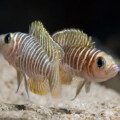



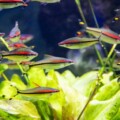
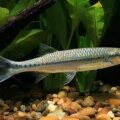

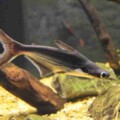
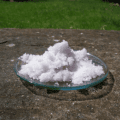
25 thoughts on “14 Small & Big Freshwater Pet Sharks for a Home Aquarium”